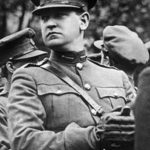Liam Neeson cast as Michael Collins in Michael Collins has much to do with his Irish background, but also his masculine appearance and representation in the media. Liam Neeson is historically a masculine character. Before Michael Collins, he starred as Ethan Frome and Oskar Schindler. Afterward, he has starred as Jean Valjean, Qui-Gon Jinn, Zeus, and Bryan Milles (in Taken)—all manly, main roles. Liam Neeson has been used in this roles for his classic masculinity and the coding he evokes in such movies.
Liam Neeson is 6 foot 4; he towers over most people with an above average height and a fairly solid build. With built muscles, and a fit physique, Neeson’s body is naturally commanding. His voice is also fairly deep, making an explicit connection with the stereotypical, classic, male as opposed to a more high-pitched voice that would bring in question one’s masculinity.
It is no mistake that Neeson was cast for the role of Michael Collins. In the early 1900s, Irish national power was often conflated with male potency, so the recovery of one would analogously recover the other. The ideal Irish male was illustrated as one who was strong, spoke Gaelic, and had autonomy over their bodies. The male body functioned as a vehicle to assert one’s masculinity, the only thing he could control for the greater independence of the Irish state. The gendered narratives leading up to and surrounding the martyrs of 1916 constructed more masculine narratives surrounding the post-1916 era than the rising itself. Irish nationalists conflated national sovereignty and masculine strength, thereby forcing the men of Ireland to be overtly masculine so as to not appear weak in the eyes of Britain.
Only a masculine figure should represent a figure as important as Michael Collins; he is closely associated with Ireland and their national identity, and to cast someone with a meak build would send a message of weakness. Collins had a strong influence in the fight for Ireland’s independence, so casting someone like Neeson continues the image of a commanding, forceful man, aligned with the masculine ideals of Ireland. Within the film itself, Alan Rickman portrays de Valera in more of an effeminate way. Physically, he is smaller and does not have as deep and commanding a voice. He comes off as almost jealous and intimidated by Collins’s assertive presence. Neeson, contrastingly, portrays Collins as physically imposing and dominant.
Neil Jordan’s choice of Liam Neeson is much more intentional than his fame, and works off his manly Irish presence.
For more of:



